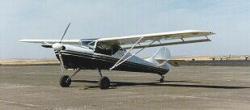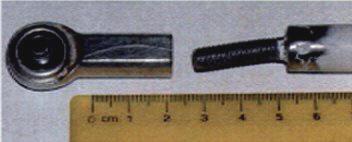Tue, May 07, 2002
Recent British Recommendation May Prove Useful

In the aftermath of the crash of an Avid Speedwing a year ago
(May 11), the Air Accidents Investigation Branch has had another
look at what could be a problem with certain Avid Flyer Speedwings
(and perhaps other, similar models).
The pilot and his passenger were badly injured in the accident,
which the AAIB seems to believe was really the result of low
airspeed. However, this design has what the AAIB considers a weak
link. It would behoove owners to check. Here's what the British
inspectors say:
Vulnerability of pitch control linkage
 Although the fracture of the pitch control
attachment fitting to the control column torque tube was assessed
as post-accident, it was not possible to discount some measure of
pre-impact bending of the threaded rod. Bending could have occurred
because there was no elevator travel stop in the aircraft nose-down
sense. After the accident the elevator was free to move to about
80° trailing edge down but it should not have done so before
the accident because of the geometry of the pitch control mechanism
which is illustrated below in a diagram supplied by a PFA
inspector.
Although the fracture of the pitch control
attachment fitting to the control column torque tube was assessed
as post-accident, it was not possible to discount some measure of
pre-impact bending of the threaded rod. Bending could have occurred
because there was no elevator travel stop in the aircraft nose-down
sense. After the accident the elevator was free to move to about
80° trailing edge down but it should not have done so before
the accident because of the geometry of the pitch control mechanism
which is illustrated below in a diagram supplied by a PFA
inspector.
This mechanism would have limited the elevator travel to less than
80°. The diagram shows that the limit of elevator down travel
is reached when the push-pull tube hits the control column torque
tube. Any forcing of the stick or the jolting of the push-pull tube
(due to forces generated at the elevator) tends to bend the
threaded rod. Opportunities to bend the rod might occur through
careless stick positioning or forcing whilst entering or leaving
the cockpit, or when the aircraft was being towed, particularly
over rough terrain, although G-BUSZ had not been towed since its
annual inspection.
Over-travel of the pitch control mechanism is a known problem with
the Avid Speedwing. There have been at least three instances of
failure or significant bending damage of this threaded rod end.
Fortunately all three instances were detected on the ground,
although, apparently, none were reported to the PFA or the CAA. A
recent occurrence is illustrated in the photograph below which was
provided by the PFA recognised 'type expert'.
Recommendation

Design deficiencies in the Speedwing's flight control systems
have been identified and simple modifications developed to
alleviate these deficiencies. For instance, Avid Directive AD004
concerns the aileron control linkage at the port end of the control
column torque tube and MOD/189/002 provides enhanced protection
against a control jam arising from collapse of the seats onto the
control runs beneath. However, at the time of the accident there
was no formal modification that addressed the vulnerability of the
pitch control linkage.
According to the PFA, the kit manufacturer developed an elevator
stop assembly in the early 1990s which they issued to constructors.
Some UK Speedwings have the stops fitted but the down stop assembly
did not reach all the constructors in time to be embodied. This
explains why G-BUSZ and some other UK examples were built without
an elevator down stop.
Recommendation 2001- 95
In view of the potential for serious damage to the pitch control
linkage within Avid Speedwing aircraft that lack an elevator travel
stop in the elevator trailing edge downwards direction, on 29
November 2001 the AAIB wrote to the Popular Flying Association
recommending that the Association should:
a. Identify a modification that introduces an effective and durable
pitch control stop in the elevator trailing edge downwards
direction.
b. Classify the modification as a Mandatory Permit Directive.
Response to recommendation 2001-95

As a result of this accident, the PFA have now issued
MOD/189/006 to all Avid owners. This modification requires owners
either to fit the standard Avid elevator stop assembly or an
equivalent stop (made to a drawing and fitted in accordance with
instructions provided) within the next 5 flying hours. The PFA
stated that an approved stop is effective, durable and operates in
the elevator down direction.
More News
Airport Rotating Beacon A visual NAVAID operated at many airports. At civil airports, alternating white and green flashes indicate the location of the airport. At military airports>[...]
Aero Linx: Fly for the Culture Fly For the Culture, Inc. is a 501(c)(3) non-profit organization that serves young people interested in pursuing professions in the aviation industry>[...]
Klyde Is Having Some Issues Comprehending The Fed's Priorities FMI: www.klydemorris.com>[...]
Also: Viasat-uAvionix, UL94 Fuel Investigation, AF Materiel Command, NTSB Safety Alert Norges Luftsportforbund chose Aura Aero's little 2-seater in electric trim for their next gli>[...]
Also: EP Systems' Battery, Boeing SAF, Repeat TBM 960 Order, Japan Coast Guard H225 Buy Despite nearly 100 complaints totaling millions of dollars of potential fraud, combined with>[...]
 ANN's Daily Aero-Term (04.25.24): Airport Rotating Beacon
ANN's Daily Aero-Term (04.25.24): Airport Rotating Beacon ANN's Daily Aero-Linx (04.25.24)
ANN's Daily Aero-Linx (04.25.24) Klyde Morris (04.22.24)
Klyde Morris (04.22.24) Airborne 04.24.24: INTEGRAL E, Elixir USA, M700 RVSM
Airborne 04.24.24: INTEGRAL E, Elixir USA, M700 RVSM Airborne 04.22.24: Rotor X Worsens, Airport Fees 4 FNB?, USMC Drone Pilot
Airborne 04.22.24: Rotor X Worsens, Airport Fees 4 FNB?, USMC Drone Pilot






